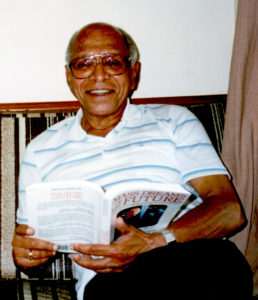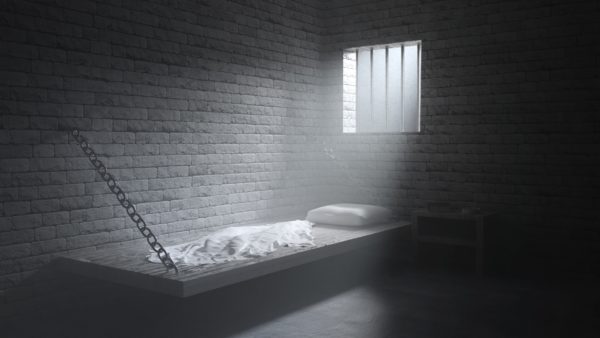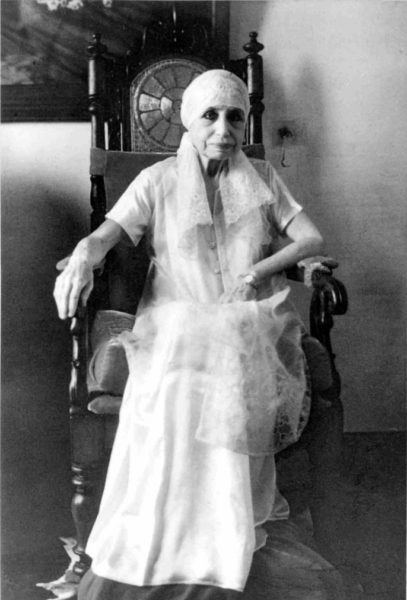Gems from the Collaboration Archive

Towards the Great Turning Point
C.V. DEVAN NAIR
GEMS FROM THE COLLABORATION ARCHIVE highlights notable articles from past issues of Collaboration journal, along with video interviews and conversations that explore the deeper aspects of each article. A roundtable discussion on the following “Gems” article is available on the Sri Aurobindo Association YouTube channel: https://www.youtube.com/watch?v=5NTjUu37SmY
This selection is taken from a talk given at the 1991 AUM Integral Yoga Conference in Madison, Wisconsin. The entire talk was originally published in two parts in the Summer/Fall and Winter 1991 issues of Collaboration and excerpted in the Fall/Winter 2002–3 issue.
WHAT WERE THE TURNING POINTS that led me to the discovery of Sri Aurobindo and the Mother? We proceed through contradictions, often very painful ones—contradictions that make us swing wildly between extremes, between exclusive sky or exclusive earth until, at last, we find ourselves suddenly placed before Something Else, which at once includes both sky and earth, height and abyss. What is up above also shines perfectly right down below.
The poetry and literature I read as a young man, in particular my readings in the great Eastern traditions, made me a fascinated votary of the utter Beyond. Heaven cancelled earth, which somehow we have to escape from. Life and the world were a disgusting hell. All the great religions were at least agreed on one thing: salvation was a post-mortem affair.
World War II and Revolutionary Years
THEN CAME THE SECOND WORLD WAR, and the Japanese military occupation of Malaya and Singapore. And the whole picture changed.
Incredible tortures and massacres, severed human heads stuck on poles at street corners; arson, rapine, and carnage everywhere. For instance, with several others I was forced, at bayonet-point, to watch as Japanese soldiers covered the head and trunk of a man with a jute rice sack soaked in kerosene, set him aflame, and watch him writhe to death on the ground in terrible, voiceless agony. Believers and unbelievers, sinners and saints, men, women, children, and suckling babes, were all alike grist for the satanic mills of torture and death. Where was God then? Where the All-Merciful and Compassionate One, the Friend of Creatures? And where the blissful Beyond? Only the communists in the anti-Japanese Resistance Army were fighting back.
A cold, ferocious anger gripped my entire being, down to my very cells, which began to throb with an unremitting hatred of tyranny and oppression. To blazing, bloody Hell with God and the Great Beyond! My revolutionary years began, and continued into the British reoccupation after the Allied victory over the fascist powers. This time the slogan was “Down with imperialism and colonialism.” I became a member of a clandestine organization called “The Anti-British League.” Once the hated colonialists were driven out, my fellow revolutionaries and I would set up a new Jerusalem in our free and independent nation.
Alas, all the new Jerusalems in all the continents continue to remain like the old Jerusalem, still marked by strife, division, bigotry, and cruelty.

Five Years in Prison
NATURALLY, WHEN THE BRITISH DISCOVERED what I and my kind were up to, they locked us up. Thus began a total of five years, in two separate spells, as a political prisoner.
When I was arrested the second time, in October 1956, I had become painfully aware that revolutionary ideals can also be betrayed by the revolutionaries themselves—for every man-made revolution is ultimately betrayed. But the most terrifying discovery was that the Devil was not only without. He was also very comfortably housed within oneself. In fact, not just one Devil, but several devils. For there are mental devils, vital devils, and physical devils right down to the cells of one’s body.
How often do we not wallow in self-pity, lamenting our current misfortunes, only to realize tomorrow or the day after that these mishaps had been rudely knocking at the doors of new opportunities and startling awakenings? There are blessed moments when we become aware that a divine prankster has all along been at work, for all the circumstances of life seem to link up in a silent conspiracy, as it were, to lead us to a seminal turning point which compels us up the ladder of consciousness, an up that sometimes takes the form of a plunge deep within, to find there what was missing all along in the noisy welter of confusion in which we live—a living, burning flame.
That second imprisonment, over a period of 31 months, was a dreadful psychological ordeal, made bearable only by an undreamed-of prison visitor, one I had never heard of before. Sri Aurobindo visited me in my cell, in the shape of an edition of The Life Divine. I had come across his name in the footnote of a book I was allowed to read. A family friend obliged by procuring a copy of the book from the university library.
It was a mind-blowing experience, and God knows that the human mind can certainly do with a great deal of blowing. As I once said elsewhere, invisible to my prison warders, magical doors and windows flew wide open in that narrow prison cell, and something in me soared out and up on wings of fire. Walls were toppled, gulfs were bridged, and heights and abysses became one in the incredibly calm, flaming immensity that was Sri Aurobindo. And all this in language of unparalleled magnificence, in sentences that breathe royalty in every word.
Invisible to my prison warders, magical doors and windows flew wide open in that narrow prison cell, and something in me soared out and up on wings of fire.
At last I began to ask the right questions, which we seldom do. “Is it not possible,” Sri Aurobindo gently suggested, “that the soul itself—not the outward mind, but the spirit within—has accepted and chosen these things as part of its development in order to get through the necessary experience at a rapid rate, to hew through, durchhauen, even at the risk or the cost of much damage to the outward life and the body? To the growing soul, to the spirit within us, may not difficulties, obstacles, attacks be a means of growth, added strength, enlarged experience, training for spiritual victory?”1
And he calmly asserted: “God’s negations are as useful to us as His affirmations.”2
Sri Aurobindo does not furnish us with a road map of yoga showing escape routes from life. On the contrary, he introduces one to the greatest revolution in earth-history—a sweeping, radical sedition against the entire existing natural order of things. His own words were: “It is not a revolt against the British government, which anyone can easily do. It is, in fact, a revolt against the whole universal Nature.”3
What happened in that prison cell was a crucial personal turning point, one that I am still negotiating today. The Life Divine provided lightning flashes of an incredible illumination.
But there remained a stubborn egoism of the intellect, which refused to disappear. The arrogant intellectual in me prided himself on his intellectual prowess. My intellect failed to see the book was, fundamentally, much more than a massive intellectual feat, which it also was. For it is possible to train the mind to be a limpid instrument of the Spirit. Above all, I failed to see, at that stage, that The Life Divine was a recordation, in terms intelligible to the human intellect, of a Great Experience. “I wrote The Life Divine,” said Sri Aurobindo, “to help people silence their minds.”
However, at my absurdly superficial intellectual level, it was still largely a case of one great intellectual appreciating another. But the time would come when the Mother would, in her infallible way, knock the great intellect silly. Oh, that incident must have been occasion for huge laughter in Heaven, for it was high comedy.
“Good Work, Mother”
IN 1964, I VISITED THE SRI AUROBINDO ASHRAM for the first time. I had little patience in those days with absurd Hindus falling over each other to touch the feet of some holy man.
I remember that once in Calcutta I went to call on an illustrious swami of the Ramakrishna Mission, the late Swami Nikhilananda, whose writings I admired. Hundreds of Indians were waiting in line for his darshan, as they call it, and to reverently touch his feet. Not the great Devan Nair, who had strutted to the place in a three-piece suit, and was allowed to jump the queue. If I may stretch a simile, it was rather like His Holiness the Pope making a courtesy call on His Holiness the Dalai Lama. The swami received me, took my proffered hand, and shook it. I congratulated him on his latest book, one on Vivekananda. But I was slightly discomfited by his smile of greeting. It was a mysterious smile. I wasn’t quite sure whether he was smiling with me, or at me.
When I arrived in Pondicherry, they arranged for me to meet the Mother. I inquired about the formalities, and was told that I could, if l liked, offer her some flowers. That struck me as a very gentlemanly thing to do. So I asked for some flowers to offer.

It was about ten in the morning when I found myself part of a line of about 20-odd people waiting in front of the Mother’s room. I was slightly irritated because nobody this time thought of inviting the Pope to jump the queue. However, I had already rehearsed in my mind what I would do when introduced to the Mother. I would present her the flowers, shake her hand, and say: “Good work, Mother. Congratulations!” Or something to that effect.
To this day I cannot explain what really happened when I stood in front of that frail old woman, seated humped in her chair. “Poor old lady,” was my first gentlemanly thought. Then my eyes fell on an extraordinarily radiant face, with a vibrant, golden glow.
Words are totally, hopelessly inadequate, to describe what happened next. I will only say this. I presented the flowers, which she took, and suddenly found myself looking into a pair of the most incredible eyes I had ever seen. There followed a convulsive inner and outer movement. And suddenly, inexplicably, I found myself on my knees, with my head on her lap. I felt a soft and gentle hand on the crown of my head.
I got to my feet in a daze. Not a word was exchanged. She gave me a red rose, which I took, and I left the room. Somehow, I walked back to the guest house, and lay on my bed. I don’t remember anything else, for I woke up only at about seven in the evening.
A Formidable Turning Point
IT WAS A FORMIDABLE INNER TURNING POINT. The intellect was humbled. The emperor realized that he was quite naked. He had no clothes, and he occupied a quaking, collapsible throne. For the first time, I began to appreciate what the poet Shelley was driving at in his powerful poem, “Ozymandias.” You may like to hear it:
I met a traveler from an antique land
Who said: “Two vast and trunkless legs of stone
Stand in the desert. Near them, on the sand,
Half sunk, a shattered visage lies, whose frown,
And wrinkled lip, and sneer of cold command,
Tell that its sculptor well those passions read
Which yet survive, stamped on these lifeless things,
The hand that mocked them and the heart that fed;
And on the pedestal these words appear:
‘My name is Ozymandias, king of kings;
Look on my works, ye Mighty, and despair!’
Nothing beside remains. Round the decay
Of that colossal wreck, boundless and bare
The lone and level sands stretch far away.”
Today, an even more colossal wreck is in the making—the modern world of science and technology. The Ozymandiases of the mind are already, visibly, beginning to reel on shaky pedestals.
There were other turning points, of which it would be even more difficult to speak. Perhaps it is wrong to speak at all. For words are often counterfeit coins, unacceptable as legal tender in the supermarket of the Spirit.
But the Mother’s power continued to work in me.
Notes
- Sri Aurobindo, Letters on Yoga I, p. 524.
- Sri Aurobindo, Essays Divine and Human, p. 498.
- Sri Aurobindo, Evening Talks with Sri Aurobindo, recorded by A.B. Purani, Dec. 23, 1923
C.V. DEVAN NAIR (1923–2005) was born on a rubber plantation in Malaya and moved to Singapore with his family when he was ten. After World War II he became a fierce revolutionary against British imperial rule and spent five years in British jails, where he discovered Sri Aurobindo. Nair was also a teacher, lawmaker, and trade union leader, shaping Singaporean workers into an economically effective force that helped the country develop one of the strongest financial positions in Asia. From 1981–85 he served as president of Singapore. Later he moved to the U.S. and was a visiting fellow of Cornell University’s Southeast Asia Program. In 2014 the Devan Nair Institute for Employment was opened in Singapore to recognize his contributions to the labor movement.
Subscribe to Collaboration
Collaboration explores the vision and work of Sri Aurobindo and the Mother, the theory and practice of Integral Yoga, and themes such as consciousness, emergence, and transformation. To subscribe, visit https://www.collaboration.org/journal/subscribe/

